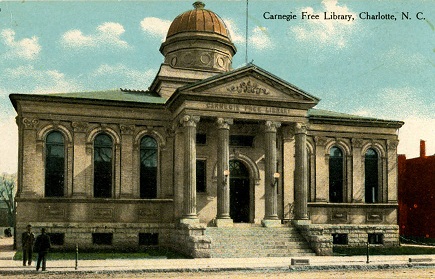Carnegie Libraries
by Eileen McGrath, 2006
See also: Public Libraries; Library, State.
 Between 1886 and 1923, industrialist Andrew Carnegie and the Carnegie Corporation donated funds for more than 1,600 public library buildings in the United States. Ten of those libraries were constructed in North Carolina. Charlotte was the first North Carolina city to apply for Carnegie funds; its application for $25,000 was approved in 1901. Greensboro applied next, in 1902, and Winston-Salem (1903), Rutherford College (1907), Hendersonville (1911), Andrews (1914), Murphy (1916), Durham (1917), and Hickory (1917) followed. In 1915 Charlotte received an additional grant of $15,000 to add a children's room and an auditorium. After several false starts, Greensboro was given a second grant in 1922 to construct a branch for African Americans.
Between 1886 and 1923, industrialist Andrew Carnegie and the Carnegie Corporation donated funds for more than 1,600 public library buildings in the United States. Ten of those libraries were constructed in North Carolina. Charlotte was the first North Carolina city to apply for Carnegie funds; its application for $25,000 was approved in 1901. Greensboro applied next, in 1902, and Winston-Salem (1903), Rutherford College (1907), Hendersonville (1911), Andrews (1914), Murphy (1916), Durham (1917), and Hickory (1917) followed. In 1915 Charlotte received an additional grant of $15,000 to add a children's room and an auditorium. After several false starts, Greensboro was given a second grant in 1922 to construct a branch for African Americans.
Carnegie's generosity spurred the creation and institutionalization of public library service in many communities. However, most towns eventually outgrew their original Carnegie buildings. In North Carolina, the period after World War II saw an expansion of collections and services that forced many of the nine towns with Carnegie libraries to build new facilities. The Carnegie libraries in Andrews, Charlotte, and Rutherford College were torn down, as was the white Carnegie library in Greensboro. Greensboro's second Carnegie library is now part of the Bennett College campus. The Carnegie buildings in Durham, Hendersonville, Hickory, Murphy, and Winston-Salem still stand, but none is used as a library.
References:
Mary E. Anders, "The Contributions of the Carnegie Corporation and the General Education Board to Library Development in the Southeast" (M.A. thesis, UNC-Chapel Hill, 1950).
George S. Bobinski, Carnegie Libraries: Their History and Impact on American Public Library Development (1969).
Wendell W. Smiley, Library Development in North Carolina before 1930 (1971).
Additional Resources:
Case, Steve and Allen, Christy. "A Brief History of North Carolina Public Libraries" Transforming the Tar Heel State: The Legacies of Public Libraries in North Carolina. State Library of North Carolina. 2008. https://statelibrary.ncdcr.gov/digital/publiclibraries/history.html
Lorenzen, Michael. "Deconstructing the Carnegie Libraries: The Sociological Reasons Behind Carnegie's Millions to Public Libraries." Illinois Libraries 81 No. 2, Spring 1999. http://www.lib.niu.edu/1999/il990275.html
Valentine, Patrick M. "Steel, Cotton, and Tobacco: Philanthropy and Public Libraries in North Carolina, 1900-1940." Libraries & Culture 31, No. 2, Spring 1996. 272-298. http://www.jstor.org/stable/10.2307/25548437.
Image Credits:
"Carnegie Free Library, Charlotte, N.C." Postcard. S. M. Kress and Co., circa 1910. https://digital.ncdcr.gov/Documents/Detail/charlotte-carnegie-free-library-exterior-view/47116.
1 January 2006 | McGrath, Eileen